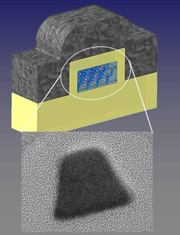
| Home | About Us | Contribute | Bookstore | Advertising | Subscribe for Free NOW! |
| News Archive | Features | Events | Recruitment | Directory |
News
1 March 2010
Tyndall claims first junctionless transistor
 Researchers at Tyndall National Institute in Cork, Ireland led by professor Jean-Pierre Colinge have reported in Nature Nanotechnology how they have designed and fabricated what is claimed to be the first junctionless transistor, which could significantly reduce power consumption and simplify the fabrication process for silicon chips, it is reckoned.
Researchers at Tyndall National Institute in Cork, Ireland led by professor Jean-Pierre Colinge have reported in Nature Nanotechnology how they have designed and fabricated what is claimed to be the first junctionless transistor, which could significantly reduce power consumption and simplify the fabrication process for silicon chips, it is reckoned.
Picture: Cross section of silicon wire with wrap-around insulator and overlaid gate.
Existing transistors are based on junctions formed by adjacent layers of semiconductor material with different dopant-atom-induced polarities. Since controlling the junction allows current in the device to be turned on and off, it is the precise fabrication of this junction that determines the characteristics and quality of the transistor and is a major factor in production costs. However, as the distance between junctions drops below 10nm, extraordinarily high doping concentration gradients become necessary. Because of the laws of diffusion and the statistical nature of the distribution of the doping atoms, such junctions require increasingly complex and costly fabrication processes.
Tyndall’s new transistor consists of a silicon nanowire (about 30nm across just 10nm thick), and it has no junctions and no doping concentration gradients, since current flow is controlled by a ‘wedding ring’ gate structure around the wire. “These structures are easy to fabricate even on a miniature scale, which leads to the major breakthrough in potential cost reduction,” claims Colinge.
Another key challenge for the semiconductor industry is reducing the power consumption of complex transistors, with minimizing current leakage one of the main challenges. The new transistors — which can be made to have full CMOS functionality — have near-ideal subthreshold slope, extremely low leakage currents, and less degradation of mobility with gate voltage and temperature than classical transistors, Tyndall claims. “They have the potential of operating faster and using less energy than the conventional transistors used in today’s microprocessors,” says Colinge.
The junctionless transistor resembles the first ideal transistor structure, proposed in 1925, but to-date no-one had been able to fabricate it, continues Colinge. He attributes Tyndall’s junctionless transistor to the ability to fabricate a silicon nanowire with a diameter of just a few dozen atoms using electron-beam writing techniques and commercial silicon-on-insulator (SOI) wafers.
“We are beginning to talk about these results with some of the world’s leading semiconductor companies, and are receiving a lot of interest in further development and possible licensing of the technology,” says Tyndall’s CEO, professor Roger Whatmore.
The work was funded by Science Foundation Ireland, and is also underpinned by substantial investments in Tyndall by the Department of Enterprise Trade and Employment and the Higher Education Authority, comments Whatmore.
Visit: www.nature.com
Visit: www.tyndall.ie/control